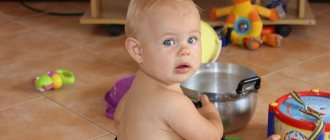Time flies by unnoticed. Just recently your little one was born, you carried a small lump in your arms. Now he is unrecognizable: the baby has radically changed in appearance, he knows and understands a lot. A child's development at 12 months is even more focused on understanding the world around him. This period is transitional, and therefore somewhat difficult for the baby and parents.
What's new in the physical development of a one-year-old child
At 12 months, the child weighs 9.5 – 10.5 kg (±1 kg) and height 74 – 76 kg (±3 cm). The increase in weight and height does not differ significantly from the previous month.
What new things can your little one do at twelve months?
- Walks by hand or independently. But he can continue to actively crawl on all fours.
- A 12-month-old child can grasp two small objects with one hand, and three or a handful with two hands.
- Confidently hands the object to an adult and lets him go. Knows how to grab a button on your clothing using a bent thumb and forefinger.
- Can squat or sit without support.
- He can build a tower from several cubes and put rings on a stick.
- He continues to master gestures, in addition to those that have already been learned (see the child at and months old), he can also: send an air kiss (if you teach him), kiss his mother, blow on something hot.
- At 12 months, the child makes attempts to eat with a spoon on his own, provided that you show him this and allow him to do it himself.
Read in detail: what a 1-year-old child can do
What's new in psychological development
- By the age of one year, a child understands more than 20 words and knows the names of objects that he sees around him every day. The pronunciation of words is still vaguely reminiscent of what it should be, syllables may be rearranged, and not all letters are pronounced. Kids put several meanings into one word;
- A child at 12 months begins to be drawn to other children, but does not yet know how to communicate without conflicts;
- Now the baby understands well how and with whom in the family he can behave. He feels the softness of his mother and allows himself to play pranks or even manipulate her. He knows that this won’t work with dad;
- By the age of 12 months, it becomes more and more difficult to play with a child; he may set some of his own rules in games that are not acceptable to you and persist in doing what he should not do: throw sand, pull the cat’s tail;
- Children around this age begin to develop long-term memory. Kids can remember what happened yesterday or a few days ago. There are people who, already as adults, are able to remember themselves at one year old;
- When a child listens to music, he tries to sing along, and while standing, he tries to dance;
- Fulfills simple requests (see child at 11 months);
- Starting approximately from the 9th month, but most often at one year, children may experience a difficult transitional moment, when they seem to become different from themselves and change radically - this is the crisis of the first year. How it manifests itself: Disobedience, stubbornness;
- A sharp increase in independence (refusal of help);
- Touchiness and tearfulness;
- Conflicting behavior (the child may get irritated when something doesn’t work out and expect help from you, but immediately refuse it).
Any mother has questions: why did the child start to behave this way? What is this: harmfulness or did I spoil him? Don't worry too much or react violently to changes. Here are the reasons why your baby’s behavior changes:
- The child gradually develops a will, which increasingly begins to collide with the will of an adult, which causes a protest on the part of the child;
- From the age of 12 months, a child’s worldview changes completely: he realizes the first signs that he is a separate person, that his parents are adults who are allowed more than him;
- As the child acquires more and more skills, his self-confidence grows and he becomes more and more independent. At the same time, the baby cannot yet adequately assess its capabilities, distribute power, or anticipate the situation. Therefore, the child seems to overestimate himself and because of this suffers failures, which, of course, drive him crazy. The child cannot accept the thought: “that he cannot do what he wants, because his mother can do it”;
- Prohibitions are perceived by the child as an obstacle to adults’ understanding of the world.
Child development test at 12 months
- The child should already be able to crawl, stand with support and take a few steps if you hold him by the arms;
- At 12 months should use 1 – 2 gestures: wave a hand, nod “yes” or “no”;
- Must say at least one meaningful word: mom, dad;
- Must be able to fulfill simple requests: give, take;
- In addition, skills acquired in previous months must be present (see child at 10 and 11 months);
- By the end of the first year, the child should have at least one tooth or swollen gums - evidence that the tooth is growing.
If the result is negative for at least one of the test points, then you should definitely visit a pediatrician.
Skills for 12 months
A child’s skills at this age are varied and can be divided into the following achievements:
Cognitive:
- Plays with a pyramid: puts on and takes off rings.
- Places cubes on top of each other.
- Imitates his peers (throws dice, claps his hands, may start breaking a toy).
- Opens and closes drawers, doors, turns everything on/off, presses buttons, etc.
Social-emotional:
- Laughs, rejoices at mom or her favorite toy.
- Shows a varied range of emotions depending on the situation: laughs, is indignant, cries.
- Shows dissatisfaction when treated rudely, if he hears “no”, “impossible”.
- Copies the facial expressions of his parents, imitates them.
- Interested in pictures in books, bright objects.
- He listens to music with interest and “sings along.”
Speech:
- Upon request, he can perform an action with a toy (give it, put it, put it in a box).
- Can pick up or show a familiar object.
- Understands the words “you can’t”, “take”, “you can”.
- Remembers the names of relatives, knows some wardrobe items.
- If they say goodbye, he waves his hand.
- He understands the game of peek-a-boo and covers his face with his palms.
Household:
- Holds a cup in his hands and drinks from it independently.
- Can bite off a cookie, an apple, a banana.
- Helps to dress himself, raises his leg.
- Some children at this age are very familiar with the potty and ask to use it, making characteristic sounds.
Child growth at 12 months - norms for boys and girls
The baby’s physical development continues actively; in a year he has grown by about 25 cm. Now, according to Russian pediatrics, the child’s height should be in the following range:
- Girls: from 71.3 to 78.1 cm.
- Boys: from 72.1 to 79.8 cm.
According to the World Health Organization (WHO), a child's growth at 1 year should be close to the following marks:
- Girls: from 68.8 to 79.3 cm.
- Boys: from 71.1 to 80.6 cm.
Baby weight at 12 months - norms for boys and girls
By this age, the baby gains 6-7 kg, subsequent weight gain will not be as active. The weight of a child at 12 months, according to domestic pediatricians, should not exceed the following marks:
- Girls: from 8.4 to 10.9 kg.
- Boys: 8.8 to 11.7 kg.
According to WHO, the weight of a child at 1 year of age should be within the following limits:
- Girls: from 7.1 to 11.6 kg.
- Boys: 7.8 to 12.1 kg.
Mode: sleep and nutrition
Parents of many one-year-old children are faced with a change in routine. We have to do this because now it becomes difficult to put the child to bed during the day at the same time, so daytime sleep has to be pushed back. This is how “night owls” manifest themselves, who wake up in the morning at 9–10 o’clock and go to bed at 14–15 o’clock in the afternoon. Thus, it turns out that such children begin to sleep during the day once for 2–3 hours, from about 14 to 17 hours, and their night sleep begins only at 22 hours or even later.
In this regard, it is necessary to accustom the baby to a different diet. If the child switches to one long nap during the day, then feeding him five times will not work. Such kids eat 4 times, for example: breakfast at 9.00, lunch at 13.00, afternoon snack at 17.00 and dinner at 21.00.
If your baby’s routine has not changed, then everything remains the same. (see child at 11 months)
Read also: 1-year-old child’s daily routine
Examination by doctors and vaccination of the baby
Regular medical examination is necessary, especially at one year of age. The new procedure for examination in 2021, approved by Order of the Ministry of Health of Russia dated August 10, 2017 N 514 n, involves examination of a one-year-old child by the following specialists:
- pediatrician
- neurologist
- pediatric surgeon
- otorhinolaryngologist
- traumatologist-orthopedist
- ophthalmologist.
In addition to the mandatory examination, blood and urine tests are examined, and electrocardiography is also performed.
In the absence of contraindications from doctors, when the child reaches the full 12 months, comprehensive vaccination is carried out. It includes: vaccination against measles, rubella, mumps and a fourth vaccination against viral hepatitis B (for children at risk).
How to help your child develop
- Continue to carry your baby in your arms periodically. (see “holding” a child at 10 months);
- The development of a one-year-old child is still aimed at improving speech and fine motor skills, so continue activities that develop these functions. (see child at 10 and 11 months);
- The most important skill that your baby is now acquiring is walking. No matter how much you want your child to start walking, it is important that he is ready for this. If the baby has mastered crawling and moves easily, then you can encourage him to start walking, but there is no need to wean him off crawling. To do this: Place your baby's favorite toys at an accessible height. As soon as you notice that the child has stood up and is reaching for the object, move it a little further away from him so that the baby takes a few steps towards the target. Don’t rush your baby; the musculoskeletal system gradually gets used to the new loads. Increase the distance gradually;
- When the child learns to take several steps on his own from support to support, create for him several such goals in the form of toys. Let the baby move from one support to another: from a chair to a crib, from a crib to a chair;
- Very often, a child is prevented from taking the first step by a feeling of uncertainty and fear of losing balance. Give him a toy for balance, step back a couple of steps and ask him to bring you the object. For many children, this is enough to dare to walk on their own;
- When you go for a walk with your child, pay his attention to other children who are already walking. Someone else's example is contagious;
- Do not overuse walkers, they can create incorrect posture (FOR and CONS of walkers). It is better to use rolling toys or reins. Support your baby by the forearms or hands, but not by the armpits. When the baby can take several steps on his own, you can belay him from behind, supporting him by the hood. Now try to use the stroller less;
- Falls are an important part of learning to walk. Do not rush to him immediately after falling; let the baby try to get up on his own. Help if the child really cannot get up or hits himself and starts crying;
- If you have somewhere to walk on grass, on sand, or just on the ground, then it will be useful to let your child walk barefoot. A baby should be taught to walk on a hard floor only in special children's shoes. The reason is that when walking, certain muscle groups in the foot are tensed, which only happens when moving on natural surfaces (earth, sand, pebbles). When a child walks on a hard floor, the foot is relaxed or not fully tense, which leads to various disorders in the gait and ankle. It should be noted that the first shoes should not be just slippers or elegant sandals, but orthopedic correct shoes. It is advisable that they be lace-up and with a high back - for stable fixation of the ankle and with a 5 mm heel - to prevent flat feet. Of course, you don’t need to keep your child in shoes all the time, but when the baby learns to walk, put them on.
Read also: 10 ways to teach a child to walk
Games
Play story games with your children: everything you saw on a walk can be played out at home with the help of toys, for example: you watched a truck unload a body. You can repeat this at home with a children's car and cubes. Or arrange fairy tale performances for your child using a children's finger theater or matryoshka dolls in the form of fairy tale characters.
It's time to rebuild your relationship with your child. Organize your games and activities with him so that they take place together, but at the same time you allow the baby to independently do what he knows. There must be sincere trust between you and the child, only in this case the baby will be able to learn from you and develop fully.
← 11 month
Speech development
The active vocabulary (those words that the baby pronounces) expands significantly every year. There may be 10-20 words in a baby’s arsenal. Their meaning still varies depending on the context.
Children are sociable and babble a lot in their own language. They can get angry if they are misunderstood.
It is important for parents to engage in the development of speech and fine motor skills. Read more or turn on audio fairy tales, comment on all your and your children’s actions.
The baby can already master drawing with plasticine. This is a great way to develop your child's speech and fingers.
You will need soft plasticine and cardboard. Place a small sheet of cardboard in front of the baby, pinch small pieces of plasticine, and roll them into balls. Let your baby place the ball on the cardboard, press the ball with his index finger and stretch it down.
Features of the daily routine at 1 year
The daily routine is undergoing changes. The time spent sleeping decreases. The baby already needs 8-10 hours of sleep at night. It becomes more and more clear whether he is a lark or an owl.
Children often switch to one nap during the day on their own. It lasts on average three hours. This affects walks. Now I can go for walks with my baby twice a day (morning, evening).
Pediatricians advise specifically transferring children to one nap during the day so as not to delay bedtime.
If the toddler is not ready for such changes, and is more irritable and capricious in the evenings, it is worth holding off on restructuring the regime.
Nutrition
By the age of one year, the toddler can move to the so-called common table. Chocolate and other allergenic foods (strawberries, tomatoes, citrus fruits) are still prohibited. The baby should not eat spicy, salty or smoked foods.
The children's menu includes cottage cheese casseroles. You can add pieces of apples or pears to them. If fish has not been introduced into your diet before, now is the time for it. It can be boiled or made into steam cutlets or baked.
Drinks for toddlers include goat's milk and compotes with minimal sugar content. Weak tea is introduced little by little. Children's yoghurts, kefir, and bifilife remain on the menu.
One-year-old children are already good at eating with a spoon and drinking from a cup. Kids learn to hold it not with both hands, but by the handle.
How do children sleep at this age?
During this period, a complete change in sleep patterns occurs. The child's temperament begins to actively manifest itself, and accordingly, his preferences in the mode .
The children begin to divide into “Owls” and “Larks”. “Owls” prefer to go to bed later at night, but they sleep peacefully until nine in the morning. And the “Larks,” like daytime birds, are already on their feet at seven in the morning, but they also go to bed no later than eight in the evening. Therefore, it makes sense to reconsider the daytime bedtime according to your child’s biological rhythms.
The general sleep pattern is eleven to twelve hours. Daytime sleep is reduced to just a couple of hours, so it is optimal to put your baby to bed around two o'clock in the afternoon.









